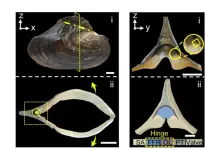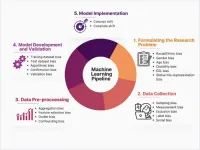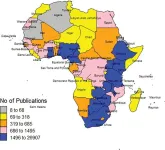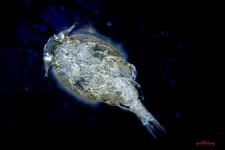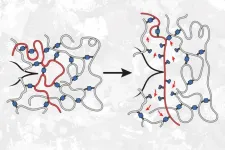(Press-News.org) An international team of astronomers has drawn a temperature map of the dust drifting within one of the oldest spiral galaxies of the Universe which provides new insights into how fast the galaxy is growing. Until now researchers have only been able to measure the temperature of most distant galaxies in broad terms, without showing how temperatures vary in individual areas.
This research, described in a paper published today in Monthly Notices of the Royal Astronomical Society (MNRAS) shows unambiguous temperature variation within the distant galaxy indicating two distinct heat sources – a supermassive black hole at the centre of the galaxy, and the heat generated by newly-formed stars in the surrounding rotating disk.
“The temperature of a galaxy's dust can vary greatly according to which region it is in,” says of the Australian National University (ANU) in Canberra, lead author of the paper. “But most of the measurements of dust temperature for distant galaxies in the past have been for the galaxy as a whole, due to limited instrument resolution.
“We were able to measure the temperature by region to region that we could determine how much heat is coming from individual sources. Previously, such mapping has mostly been limited to nearby galaxies.”
The research reveals a clear distinction between warm dust in the central region – where the heat is derived from the galaxy’s supermassive black hole – and colder dust in the outer region, which is likely being heated by star formation.
Most galaxies have a supermassive black hole in the centre, which are thought to grow in mass with the galaxy. When the gas accretes to the black hole, it is heated up by collisions of the fast-moving particles in the vicinity of the black hole and sometimes shines brighter than the stellar body of the galaxy itself.
“The heating energy from the black hole reflects the amount of the gas being fed into it and so the black hole growth rate, while the heating energy from star formation reflects the number of stars newly forming in the galaxy – the galaxy growth rate,” Dr Tsukui says.
“This discovery provides a clearer picture of how galaxies and central massive black hole form and grow in the early Universe.”
The current research was made possible thanks to the Atacama Large Millimeter/submillimeter Array (ALMA) telescope operated by the European Southern Observatory (ESO) in Chile.
“This study demonstrates the detailed mapping ability of the ALMA telescope, operated by ESO,” Astro3D Director Professor Emma Ryan-Weber said. “ALMA is the most powerful array for measuring millimetre and submillimetre radiation. It’s incredible that ALMA can look at a 12-billion year old galaxy and separate the image into two components – one of dust heated from the central super massive hole, and the other from the dust in underlying host galaxy.”
ALMA is a global collaboration and comprises 66 high-precision antennas, spread over distances of up to 16 kilometres making it the world’s largest ground-based astronomical project. It is designed to detect faint light from some of the coldest objects in the Universe which have wavelengths of around a millimetre, somewhere between infrared light and radio waves.
The $40 million ARC Centre of Excellence for All Sky Astrophysics in 3 Dimensions (ASTRO 3D) is funded by the Australian Research Council (ARC) and six collaborating Australian universities: The Australian National University, The University of Sydney, The University of Melbourne, Swinburne University of Technology, The University of Western Australia, and Curtin University.
END
Heat spots reveal growth rate of a galaxy 12 billion years ago
Precise mapping of temperature variation gives clue to its evolution
2023-06-22
ELSE PRESS RELEASES FROM THIS DATE:
Scientists learn from hinge in bivalve about fatigue resistance of materials
2023-06-22
Recently, flexible and foldable devices have developed at a dramatic rate. More and more foldable devices appear in people's lives. Long-term service requires the folded parts to endure repeated deformation which might cause fatigue damage to the devices. Consequently, the damage will affect the normal function of the devices. Inspired by the hinge of bivalve Cristaria plicata, which experiences hundreds of thousands of repeating opening-and-closing valve motions throughout the bivalve’s lifetime, a research team led by Prof. YU Shuhong collaborating with Prof. WU Hengan from the University of Science and Technology of China ...
Bias in AI algorithms could be mitigated by implementing new checklist
2023-06-22
In your coverage, please use this URL to provide access to the freely available article in PLOS Digital Health: https://journals.plos.org/digitalhealth/article?id=10.1371/journal.pdig.0000278
Article Title: Bias in artificial intelligence algorithms and recommendations for mitigation
Author Countries: Jordan, United States, Canada
Funding: The authors received no specific funding for this work. END ...
Africa's share of global HIV research output has increased from 5.1% to 31.3% over the last 35 years, but is still low compared to its relative burden of infections
2023-06-22
Article URL: https://journals.plos.org/globalpublichealth/article?id=10.1371/journal.pgph.0000544
Article Title: HIV research output in African Countries between 1986–2020
Author Countries: Nigeria, USA, UK
Funding: The authors received no specific funding for this work. END ...
How might generative AI models distort human beliefs?
2023-06-22
Generative AI models such as ChatGPT, DALL-E, and Midjourney all have features that may distort human beliefs through their transmission of false information and stereotyped biases, according to Celeste Kidd and Abeba Birhane. In this Perspective, they discuss how research on human psychology can explain why generative AI could be particularly powerful in distorting beliefs. The capabilities of generative AI have been exaggerated at this point, they suggest, leading to a belief that these models exceed human capabilities. People are predisposed to adopt the information of knowledgeable, confident agents like generative AI ...
Large herbivores slow Arctic tundra diversity losses associated with sea ice decline
2023-06-22
Tundra diversity, including plants, lichens and fungi, declined over a 15-year experiment in the Arctic due to warming temperatures mediated by the disappearance of sea ice, according to Eric Post and colleagues. However, the presence of large herbivores such as caribou and musk oxen slowed this decline, by affecting the plant understory with their different browsing behaviors, the researchers concluded. Their findings offer support for the idea that encouraging herbivore diversity in the tundra could temper some of the impacts of climate warming. Post et al. observed the interacting effects of warming temperatures, sea ice changes, tundra diversity and herbivore exclusion in ...
Hard and soft materials form a fatigue-resistant fan in the mussel’s hinge
2023-06-22
How does a mussel shell open and shut easily and without damage for hundreds of thousands of cycles during the bivalve’s lifetime? Such fatigue-resistant materials would be useful in electronics, aerospace and tissue engineering designs, where components need to operate repeatedly without failure. Xiang-Sen Meng and colleagues took a closer look at the hinge on the shell of the bivalve Cristaria plicata, and found that the answer lies in a combination of design and materials that resist brittle fracture over time. Microscopic observations by Meng et al. show that the hinge gets its ...
Laws restricting abortion have ethical, legal and practical impacts for research on people who may become pregnant
2023-06-22
In this Policy Forum, Jeremy Sugarman and colleagues describe the risks that increasingly limited access to abortion may pose to clinical research participants and staff, one year after the U.S. Supreme Court’s decision in Dobbs v. Jackson Woman’s Health Organization. People who may become pregnant are already an understudied population in clinical research. The authors suggest that new laws restricting abortion access may lead to ethical, legal and practical problems that make the risk of conducting research with this population unreasonable ...
Are viruses keeping sea lice at bay in wild salmon?
2023-06-22
More than 30 previously unknown RNA viruses in sea lice have been identified by University of British Columbia (UBC) researchers. Sea lice are parasitic copepods (small crustaceans) found in many fresh and saltwater habitats, and have been implicated in the decline of wild salmon populations. The research sheds greater light on the types of viruses being carried by sea lice, and how the viruses and host are interacting.
“We found many more types of viruses than are known in sea lice or their distant relatives; the lice are mounting an immune defense response to many of these viruses indicating that they are replicating,” says UBC marine microbiologist Dr. Curtis Suttle, ...
The molecular control centre of our protein factories
2023-06-22
Based on genetic blueprints, individual amino acids are assembled into long amino acid chains, the proteins, in the protein factories of our cells, the ribosomes. Each newly formed protein starts with the amino acid methionine. This amino acid is often split off again during protein synthesis, as soon as the growing amino acid chain leaves the protein factory through the "ribosomal tunnel". In these cases, the excision of methionine is essential to ensure the subsequent function of the corresponding ...
Surprise! Weaker bonds can make polymers stronger
2023-06-22
CAMBRIDGE, MA -- A team of chemists from MIT and Duke University has discovered a counterintuitive way to make polymers stronger: introduce a few weaker bonds into the material.
Working with a type of polymer known as polyacrylate elastomers, the researchers found that they could increase the materials’ resistance to tearing up to tenfold, simply by using a weaker type of crosslinker to join some of the polymer building blocks.
These rubber-like polymers are commonly used in car parts, and they are also often used as the “ink” for ...
LAST 30 PRESS RELEASES:
Researchers identify gene that calms the mind and improves attention in mice
Artificial metabolism turns waste CO2 into useful chemicals
Ancient sea anemone sheds light on animal cell type evolution
Begging gene leads to drone food
How climate policies that incentivize and penalize can drive the clean energy transition
Can community awareness campaigns in low-resource areas improve early diagnosis of colorectal cancer?
Stardust study resets how life’s atoms spread through space
Practical education: Clinical scenario-based program development
The impact of family dynamics on eating behaviour – how going home for Christmas can change how you eat
Tracing the quick synthesis of an industrially important catalyst
New software sheds light on cancer’s hidden genetic networks
UT Health San Antonio awarded $3 million in CPRIT grants to bolster cancer research and prevention efforts in South Texas
Third symposium spotlights global challenge of new contaminants in China’s fight against pollution
From straw to soil harmony: International team reveals how biochar supercharges carbon-smart farming
Myeloma: How AI is redrawing the map of cancer care
Manhattan E. Charurat, Ph.D., MHS invested as the Homer and Martha Gudelsky Distinguished Professor in Medicine at the University of Maryland School of Medicine
Insilico Medicine’s Pharma.AI Q4 Winter Launch Recap: Revolutionizing drug discovery with cutting-edge AI innovations, accelerating the path to pharmaceutical superintelligence
Nanoplastics have diet-dependent impacts on digestive system health
Brain neuron death occurs throughout life and increases with age, a natural human protein drug may halt neuron death in Alzheimer’s disease
SPIE and CLP announce the recipients of the 2025 Advanced Photonics Young Innovator Award
Lessons from the Caldor Fire’s Christmas Valley ‘Miracle’
Ant societies rose by trading individual protection for collective power
Research reveals how ancient viral DNA shapes early embryonic development
A molecular gatekeeper that controls protein synthesis
New ‘cloaking device’ concept to shield sensitive tech from magnetic fields
Researchers show impact of mountain building and climate change on alpine biodiversity
Study models the transition from Neanderthals to modern humans in Europe
University of Phoenix College of Doctoral Studies releases white paper on AI-driven skilling to reduce burnout and restore worker autonomy
AIs fail at the game of visual “telephone”
The levers for a sustainable food system
[Press-News.org] Heat spots reveal growth rate of a galaxy 12 billion years agoPrecise mapping of temperature variation gives clue to its evolution
